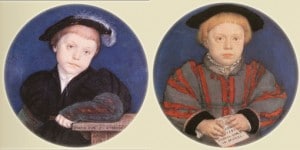
On this day in history, 14th July 1551, the fifteen year-old Henry Brandon, 2nd Duke of Suffolk, and his fourteen year-old brother, Charles, 3rd Duke of Suffolk, died of sweating sickness at the home of the Bishop of Lincoln in Buckden, Huntingdonshire. Charles survived his brother by under an hour, becoming 3rd Duke of Suffolk on his brother’s death. When Charles died, the title became extinct.
The boys were the sons of Charles Brandon, 1st Duke of Suffolk, and his fourth wife Catherine Willoughby, Baroness Willoughby de Eresby and Duchess of Suffolk. Henry Brandon had carried the orb at Edward VI’s coronation procession in 1547 and both boys had been created Knights of the Bath by the new King. They entered St John’s College, Cambridge, in autumn 1549 and studied with the German theologian Martin Bucer, who became good friends with their mother, who was staying in Kingston, a village just outside Cambridge. When an epidemic of the sweating sickness broke out in Cambridge in July 1551 the boys were moved to Buckden, but it was too late. The Duchess, who had been ill at her own home in Kingston, arrived at Buckden in time to see Charles before he died. She was understandably devastated at the loss of her two sons.
The boys were buried privately at Buckden and then a special requiem mass, known as “A Month’s Mind”, was celebrated on 22nd September 1551. John Strype writes that “it was performed with two standards, two banners, great and large, ten bannerols, with divers coats of arms; two helmets, two swords, two targets crowned, two coats of arms; two crests, and ten dozen of escutcheons crowned; with lamentation that so noble a stock was extinct in them.”
Notes and Sources
- Read, Evelyn (1963) My Lady Suffolk, p83-84
- Strype, John Ecclesiastical Memorials Relating Chiefly to Religion, and the Reformation of It, and the Emergencies of the Church of England, Under King Henry VIII, King Edward VI, and Queen Mary I, Volume II, p496